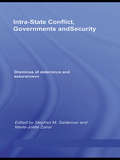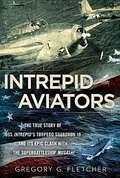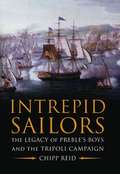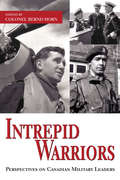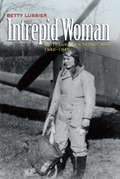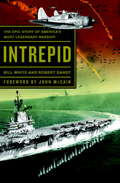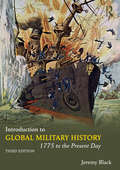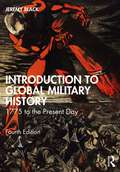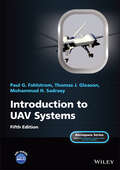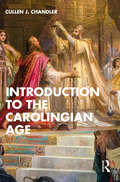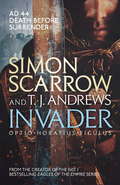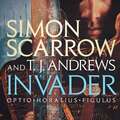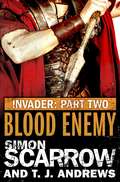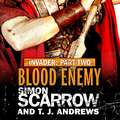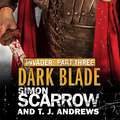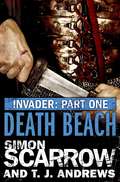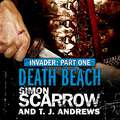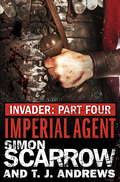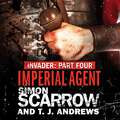- Table View
- List View
Intoxicating (An Oregon Wine Country Romance #2)
by Heather HeyfordIn the second book of Heather Heyford’s series, set in Oregon’s wine country, having a crush takes on a whole new meaning when a lady sommelier teams up with the hottie from her high school days . . . The Girl Most Likely. . . to be a waitress at her hometown café. That’s what Clarkston’s high school yearbook said about Poppy Springer ten years ago and that’s where the beauty queen is today. But that’s about to change now that Poppy has been offered a position as a lady sommelier at a cutting-edge new restaurant. Only Poppy has an embarrassing secret that could keep her from landing her dream job. A secret her high school crush seems determined to help her with . . . The Man Most WantedIn high school, Heath Sinclair may have been voted most likely to blow something up, but these days the sexy science prodigy is a self-made success story with his popular microbrewery and chiseled good looks. So why is Clarkston’s most-eligible man so hell-bent on helping Poppy prove that she is more than her reputation? Could it be the enigmatic bachelor has a hankering for the girl who got away?
Intra-State Conflict, Governments and Security: Dilemmas of Deterrence and Assurance (Contemporary Security Studies)
by Stephen M. Saideman Marie-Joëlle ZaharThis volume seeks to understand the central role of governments in intra-state conflicts.The book explores how the government in any society plays two pivotal roles: as a deterrent against those who would use violence; and as a potential danger to the society. These roles come into conflict with each other, as those governments that can best deter
Intrepid Aviators
by Gregory G. FletcherThe true story of the World War II Pacific naval battle that pitted the USS Intrepid's naval aviators against Japan's superbattleship Musashi. . . and made a dramatic difference in the Battle of Leyte Gulf. October 24, 1944: As World War II raged, six young American torpedo bombers were sent on a search-and-destroy mission in the Sibuyan Sea. Their target: the superbattleship Musashi, the pride of the Imperial Japanese Navy. The pilots were tasked with preventing the immense enemy warship from inflicting damage on American supply ships. Little did these men know that they had embarked on the opening round of history’s greatest-and last-epic naval battle. Two bomber crews launched in the first wave of attackers were shot out of the sky. Only pilot Will Fletcher survived the crash landing. Adrift at sea, Will made his way to land and escaped into the jungles of the Philippines, where he eluded capture by the Japanese with the help of Filipino guerrillas, whose ranks he joined to fight against their common enemy. Intrepid Aviators is the thrilling true story of these brave bomber pilots, their daring duel with the Musashi, and Will Fletcher’s struggle to survive as a guerrilla soldier. The sinking of Musashi inflicted a crucial blow in the Battle of Leyte Gulf and marked the first time in history that aviators sank a Japanese battleship on the high seas. MAIN SELECTION OF THE MILITARY BOOK CLUB INCLUDES PHOTOGRAPHS .
Intrepid Sailors
by Chipp ReidReid tells one of the greatest sea stories in the history of the U.S. Navy. Under Commodore Edward Preble, the Navy came of age fighting the scourge of the time, the infamous Barbary Pirates. Intrepid Sailors chronicles the Navy's campaign to subdue the pirate leader of Tripoli, who declared war on the United States in 1801. After two failed campaigns, Preble took command of the U.S. squadron in the Mediterranean and served notice to world the U.S. Navy would be a force with which to reckon.Among the ships in Preble's flotilla was a non-descript little ketch. Once a French supply boat, the ketch served Tripoli until the U.S. squadron captured her in 1803. Upon her capture, Preble incorporated the little boat into his force, re-naming her the Intrepid. She was the first ship in the United States Navy to bear the name of Intrepid and would play a central role in some of the primary feats of "Preble's Boys."The exploits of the officers and sailors in this campaign are the stuff of legend. In culling myth from fact, Reid went back to original sources, using the words of the men in the campaign to tell their story. Whether it is Decatur leading the daring raid to burn the captured frigate Philadelphia or the escape attempts of American prisoners in Tripoli, Intrepid Sailors brings to life a story many Americans once widely knew but that today has become little more than footnote.Unlike other books on the topic, however, Intrepid Sailors delves into the development of officers and sailors under Preble. Most were half the age of their commander and few had major combat experience. Under Preble, these men forged a legacy of professionalism to which the Navy still adheres. The book also examines one of the most famous friendships in American and Navy history - that of Decatur and Somers. Their thirst for glory and utter devotion to making the U.S. Navy a permanent, respected force inspired all around them but that quest for immortality never caused a breach in their friendship. Instead, that friendship grew stronger, providing even more inspiration. Intrepid Sailors offers a rare insight into the lives of men who today loom larger-than-life and who continue to inspire each new class of naval officer. Stephen Decatur, Richard Somers, Charles Stewart, James Lawrence, Edward Preble and a pantheon of early U.S. Navy heroes all come to life.
Intrepid Warriors: Perspectives on Canadian Military Leaders
by Colonel Bernd HornCommand and leadership are very personal endeavours. The manner in which an individual commands others and exercises leadership speaks more to the character and personality of the individual in question than it does to the concept of command or leadership in and of themselves. Intrepid Warriors takes an intimate look at a number of Canada’s finest military commanders and leaders during the crucible of war. Collectively, the chapters in this volume offer invaluable insights into different command and leadership approaches, behaviours, and styles. They also reinforce the timeless truth that the character and presence of courageous leaders are critical to military outcomes, particularly during times of ambiguity, uncertainty, and chaos.
Intrepid Woman
by Betty LussierA college student in Maryland when World War II began, Betty Lussier went to England to help the British fight off an impending invasion. Armed with a private pilot s license, she joined the Air Transport Auxiliary and was soon ferrying planes and pilots for the RAF, and her memoir describes those days in thrilling detail. After the Normandy invasion, when women pilots were barred from delivering planes to the combat zones on the continent, she complained to Sir William S. Stephenson, who was in the RAF with her father in World War I and headed British intelligence in the States. He steered her to the newly formed American Office of Strategic Services, which was recruiting field agents. Her experiences with a special liaison unit in Algeria, Sicily, Italy, and France helping to set up a chain of double agents and transmit misinformation to the enemy are described in compelling detail as she takes the reader step-by-step through some memorable cases that helped bring the war to an end.
Intrepid: The Epic Story of America's Most Legendary Warship (Redbooks)
by John Mccain Bill White Robert GandtThe first official history of the legendary aircraft carrier that fought in World War II and Vietnam and continues to serve as a major air and space museum in New York CityThe USS Intrepid is a warship unlike any other. Since her launching in 1943, the 27,000-ton, Essex-class aircraft carrier has sailed into harm's way around the globe. During World War II, she fought her way across the Pacific--Kwajalein, Truk, Peleliu, Formosa, the Philippines, Okinawa--surviving kamikaze and torpedo attacks and covering herself with glory. The famous ship endured to become a Cold War attack carrier, recovery ship for America's first astronauts, and a three-tour combatant in Vietnam. In a riveting narrative based on archival research and interviews with surviving crewmen, authors Bill White and Robert Gandt take us inside the war in the Pacific. We join Intrepid's airmen at the Battle of Leyte Gulf, in October 1944, as they gaze in awe at the apparitions beneath them: five Japanese battleships, including the dreadnoughts Yamato and Musashi, plus a fleet of heavily armored cruisers and destroyers. The sky fills with multihued bursts of anti-aircraft fire. The flak, a Helldiver pilot would write in his action report, "was so thick you could get out and walk on it." Half a dozen Intrepid aircraft are blown from the sky, but they sink the Musashi. A few months later, off Okinawa, they again meet her sister ship, the mighty Yamato. In a two-hour tableau of hellfire and towering explosions, Intrepid's warplanes help send the super-battleship and 3,000 Japanese crewmen to the bottom of the sea. We're next to nineteen-year-old Alonzo Swann in Gun Tub 10 aboard Intrepid as he peers over the breech of a 20-mm anti-aircraft gun. He's heard of kamikazes, but until today he's never seen one. Swann and his fellow gunners are among the few African Americans assigned to combat duty in the U.S. Navy of 1944. Blazing away at the diving Japanese Zero, Swann realizes with a dreadful certainty where it will strike: directly into Gun Tub 10.The authors follow Intrepid's journey to Vietnam. "MiG-21 high!" crackles the voice of Lt. Tony Nargi in his F-8 Crusader. It is 1968, and Intrepid is again at war. Launching from Yankee Station in the Tonkin Gulf, Nargi and his wingman have intercepted a flight of Russian-built supersonic fighters. Minutes later, after a swirling dogfight over North Vietnam, Nargi--and Intrepid--have added another downed enemy airplane to their credit. Intrepid: The Epic Story of America's Most Legendary Warship brings a renowned ship to life in a stirring tribute complete with the personal recollections of those who served aboard her, dramatic photographs, time lines, maps, and vivid descriptions of Intrepid's deadly conflicts. More than a numbers-and-dates narrative, Intrepid is the story of people--those who sailed in her, fought to keep her alive, perished in her defense--and powerfully captures the human element in this saga of American heroism.
Introduction to Global Military History: 1775 to the Present Day
by Jeremy BlackThis lucid account of military developments around the modern world begins with the American War of Independence and the French revolutionary wars and continues chronologically to the latest 21st century conflicts. It combines determinedly global coverage with thought-provoking analysis not only of the military aspects of conflict but also its social, cultural, political and economic dimensions and consequences. By placing familiar events alongside the largely unknown, the reader is forced to reassess the standard grand narrative of military history that rests on assumptions of Western cultural and technological superiority. It will be essential reading for students worldwide, whether studying modern military history, modern world history, history and international relations or war and society. This fully updated second edition includes: chapter introductions and conclusions to assist study and revision 'Voices of War' sourced extracts from the field of conflict case studies in each chapter to support the narrative and provoke discussion a 12-page colour map section and over 20 other integrated maps annotated references from the latest publications in the field
Introduction to Global Military History: 1775 to the Present Day
by Jeremy BlackIntroduction to Global Military History provides a lucid and comprehensive account of military developments around the modern world from the eighteenth century up to the present day. Beginning with the background to the American War of Independence and the French Revolutionary wars and ending with the recent conflicts of the twenty-first century, this third edition combines fully up-to-date global coverage with close analysis not only of the military aspects of war but also its social, cultural, political and economic dimensions and repercussions. The new edition includes a fully revised chapter on conflicts during the eighteenth century, updated coverage of events post-1990 and increased coverage of non-Western conflicts to provide a truly international account of the varied and changing nature of modern military history. Covering lesser-known conflicts as well as the familiar wars of history and illustrated throughout with maps, primary source extracts and case studies, it is essential reading for all students of modern military history and international relations.
Introduction to Global Military History: 1775 to the Present Day
by Jeremy BlackNow in its fourth edition, Introduction to Global Military History is an accessible, up-to-date account of modern warfare from the eighteenth century to the present.The book engages with the social, cultural, political and economic contexts of war, examining the causes and consequences of conflict beyond national and chronological boundaries. It challenges the dominant Western-centric, technologically focused view of military history and instead emphasises the ranges of circumstances faced by both Western and non-Western powers and the absence of any one direction of development. The chapters present integrated discussions of land, naval and air conflicts, addressing continuities and the ways in which common experiences affected different spheres. This edition revises the text throughout, has increased focus on the developments of the 2000s and 2010s, and adds a new chapter on the 2020s.Supported by a variety of illustrations, maps and case studies, this study is a valuable resource for students of military history and general readers alike.
Introduction to International Relations: Us and Others, Disparity and Dissatisfaction, Trust and Distrust, Legitimacy and Illegitimacy
by Atsushi TagoThis textbook provides a comprehensive introduction for individuals who are new to the discipline of International Relations or World Politics. It features three distinctive elements. First, it posits that understanding the international political economy is essential before delving into analyses of war and security, emphasizing that economic interdependence, arising from international cooperation, is a central theme in international relations. Second, the textbook recognizes that strategic interaction — where the decisions of one entity and future outcomes depend on the choices of another — is a core component of international relations. It also utilizes four key concepts in its exploration of the field: Us and Others, Disparity and Dissatisfaction, Trust and Distrust, and Legitimacy and Illegitimacy. Lastly, the textbook is attuned to the methodologies of the Social Sciences, including descriptive, causal, and deductive inferences, and it stands out for its commitment to fostering methodological awareness.
Introduction to UAV Systems (Aerospace Series)
by Mohammad H. Sadraey Paul G. Fahlstrom Thomas J. GleasonIntroduction to UAV Systems The latest edition of the leading resource on unmanned aerial vehicle systems In the newly revised Fifth Edition of Introduction to UAV Systems, an expert team of aviators, engineers, and researchers delivers the fundamentals of UAV systems for both professionals and students in UAV courses. Suitable for students in Aerospace Engineering programs, as well as Flight and Aeronautics programs, this new edition now includes end-of-chapter questions and online instructor ancillaries that make it an ideal textbook. As the perfect complement to the author’s Design of Unmanned Aerial Systems, this book includes the history, classes, and missions of UAVs. It covers fundamental topics, like aerodynamics, stability and control, propulsion, loads and structures, mission planning, payloads, and communication systems. Brand-new materials in areas including autopilots, quadcopters, payloads, and ground control stations highlight the latest industry technologies. The authors also discuss: A thorough introduction to the history of unmanned aerial vehicles, including their use in various conflicts, an overview of critical UAV systems, and the Predator/Reaper A comprehensive exploration of the classes and missions of UAVs, including several examples of UAV systems, like Mini UAVs, UCAVs, and quadcopters Practical discussions of air vehicles, including coverage of topics like aerodynamics, flight performance, stability, and control In-depth examinations of propulsion, loads, structures, mission planning, control systems, and autonomy Perfect for professional aeronautical and aerospace engineers, as well as students and instructors in courses like Unmanned Aircraft Systems Design and Introduction to Unmanned Aerial Systems, Introduction to UAV Systems is an indispensable resource for anyone seeking coverage of the latest industry advances and technologies in UAV and UAS technology.
Introduction to the Carolingian Age
by Cullen J. ChandlerIntroduction to the Carolingian Age provides an accessible history of western Europe in the eighth and ninth centuries, when arguably a truly European civilization emerged out of the transformed, former world of the Roman Empire.Through a thematical and chronological approach, this book explores the life, family, and period of Charlemagne in a clear and informative way. The secular aristocrats, ecclesiastical figures, and scholars associated with the Carolingian dynasty feature as partners in building the empire and guiding its development, and the social and cultural lives of people from the elite to the common classes are also examined. Through an engaging narrative, this study demonstrates that by the end of the ninth century, the royal house faced a series of challenges that brought about the devolution of the empire into smaller kingdoms and the loosening of the Carolingian family’s grip on monarchy. Based on up-to-date scholarship, Introduction to the Carolingian Age offers explanations of historical developments and discussions of key historiographical debates.This book is an essential resource for both undergraduate students and general readers with an interest in the history of the Carolingian period from 750–900.
Introduction to the Navy Junior Reserve Officer Training Corps
by Celeste Fraser Thomas J. Baerwald Kathy Teer Crumpler Diane Sukiennik Lisa Raufman William Bendat Deborah Prothrow-Smith B. E. Buzz PruittThis book prepares students for Navy Junior Reserve Officer Training Corps. Excerpts taken from: Health Skills for Wellness, Third Edition, The Career Fitness Program: Exercising Your Options, Sixth Edition, and World Geography: Building a Global Perspective.
Invader
by Simon Scarrow T. J. AndrewsINVADER is a Sunday Times bestseller from Simon Scarrow (author of the bestsellers BRITANNIA and CENTURION) and T. J. Andrews, co-author of the bestselling INVADER. Featuring the Roman army officer Figulus in first-century Britannia, INVADER is not to be missed by readers of Conn Iggulden and Bernard Cornwell.Roman Britain, AD 44. The land is far from tamed. A puppet king is doing little to calm the hatred of the native tribes.Fighting is in Optio Horatius Figulus' blood. His Celtic ancestry gives him the toughness essential for survival. That toughness will be tested to the very limit when he is sent on a mission deep in hostile territory. And Figulus knows that, even utterly crushed in battle, their warriors routed and the Druids driven from their hill forts, the tribesmen of Britannia will sooner die than surrender.Figulus fought alongside Macro and Cato in Simon Scarrow's bestselling Eagles of the Empire series. In INVADER, he stands alone.INVADER has previously been published in five separate ebook novellas.
Invader
by Simon Scarrow T. J. AndrewsINVADER is a Sunday Times bestseller from Simon Scarrow (author of the bestsellers BRITANNIA and CENTURION) and T. J. Andrews, co-author of the bestselling INVADER. Featuring the Roman army officer Figulus in first-century Britannia, INVADER is not to be missed by readers of Conn Iggulden and Bernard Cornwell.Roman Britain, AD 44. The land is far from tamed. A puppet king is doing little to calm the hatred of the native tribes.Fighting is in Optio Horatius Figulus' blood. His Celtic ancestry gives him the toughness essential for survival. That toughness will be tested to the very limit when he is sent on a mission deep in hostile territory. And Figulus knows that, even utterly crushed in battle, their warriors routed and the Druids driven from their hill forts, the tribesmen of Britannia will sooner die than surrender.Figulus fought alongside Macro and Cato in Simon Scarrow's bestselling Eagles of the Empire series. In INVADER, he stands alone.INVADER has previously been published in five separate ebook novellas.
Invader
by Simon Scarrow T. J. AndrewsFrom the author of the Sunday Times bestsellers BRITANNIA, CENTURION and THE GLADIATOR, and co-author with T. J. Andrews of the Sunday Times bestseller ARENA, comes a tense, action-packed adventure with the Roman army officer Figulus in the heart of barbaric first-century Britannia. Roman Britain, AD 44. The land is far from tamed. A puppet king is doing little to calm the hatred of the native tribes and bring them under Roman rule.Fighting is in Optio Horatius Figulus' blood. His Celtic ancestry is mocked by his fellow soldiers, but it gives him the toughness essential for survival. That toughness will be tested to the very limit when he is sent on a mission deep in hostile territory.And Figulus understands the Celtic mind. He knows that, even utterly crushed in battle, their warriors routed and the Druids driven from their hill forts, the tribesmen of Britannia will sooner die than surrender.Figulus fought alongside Macro and Cato in Simon Scarrow's bestselling Eagles of the Empire series. In INVADER, he stands alone.INVADER has previously been published in five separate ebook novellas. This print edition brings the complete series together in one volume.
Invader: Blood Enemy (2 in the Invader Novella Series)
by Simon Scarrow T. J. AndrewsThe second novella in the gripping INVADER series, set in Roman Britain, AD 44, from Sunday Times bestselling authors Simon Scarrow and T. J. AndrewsBritannia is a nightmare campaign setting for the brave soldiers of the Second Legion. Horatius Figulus, a junior officer, has been rewarded for bravery and skill against the island's rebel forces with a mission that could bring him prestige and position. He and his most trusted comrades are to help install a new king in a hostile area. Succeed, and they'll establish an imperative Roman stronghold. Fail, and the whole invasion will be jeopardised.Under constant attack from raiders, plagued by ruthless Druids and up against hostile natives, Figulus and his men will need all their courage and ingenuity to succeed.
Invader: Blood Enemy (2 in the Invader Novella Series)
by Simon Scarrow T. J. AndrewsThe second novella in the INVADER series, set in Roman Britain, AD 44, from Sunday Times bestselling authors Simon Scarrow and T. J. AndrewsBritannia is a nightmare campaign setting for the brave soldiers of the Second Legion. Horatius Figulus, a junior officer, has been rewarded for bravery and skill against the island's rebel forces with a mission that could bring him prestige and position. He and his most trusted comrades are to help install a new king in a hostile area. Succeed, and they'll establish an imperative Roman stronghold. Fail, and the whole invasion will be jeopardised.Under constant attack from raiders, plagued by ruthless Druids and up against hostile natives, Figulus and his men will need all their courage and ingenuity to succeed.(P)2018 Headline Publishing Group Ltd
Invader: Dark Blade (3 in the Invader Novella Series)
by Simon Scarrow T. J. AndrewsThe third novella in the gripping INVADER series, set in Roman Britain, AD 44, from Sunday Times bestselling authors Simon Scarrow and T. J. AndrewsDespite defeat in battle, Britannia's natives continue to resist their Roman conquerors. All attempts to impose Roman rule have failed. A new king has been installed among the Durotriges to bring them into line and Optio Horatius Figulus of the Second Legion is charged with protecting him. It's a thankless task and, worse still, the Druids are rumoured to be plotting to assassinate the king. The king begins a devastating campaign of reprisals against his political rivals. Whole families are murdered, weapons are confiscated and the old gods are denounced. As open native rebellion threatens, Figulus finds his unswerving allegiance to Rome faltering. Just as a Druid assassin is poised to strike...
Invader: Dark Blade (3 in the Invader Novella Series)
by Simon Scarrow T. J. AndrewsThe third novella in the gripping INVADER series, set in Roman Britain, AD 44, from Sunday Times bestselling authors Simon Scarrow and T. J. AndrewsDespite defeat in battle, Britannia's natives continue to resist their Roman conquerors. All attempts to impose Roman rule have failed. A new king has been installed among the Durotriges to bring them into line and Optio Horatius Figulus of the Second Legion is charged with protecting him. It's a thankless task and, worse still, the Druids are rumoured to be plotting to assassinate the king. The king begins a devastating campaign of reprisals against his political rivals. Whole families are murdered, weapons are confiscated and the old gods are denounced. As open native rebellion threatens, Figulus finds his unswerving allegiance to Rome faltering. Just as a Druid assassin is poised to strike...(P)2014 Headline Publishing Group Ltd
Invader: Death Beach (1 in the Invader Novella Series)
by Simon Scarrow T. J. AndrewsThe first novella in the gripping INVADER series, set in Roman Britain, AD 44, from Sunday Times bestselling authors Simon Scarrow and T. J. AndrewsThe invasion of Britannia has been bloody and relentless, and still the barbaric islanders have not been fully conquered. The men of the Second Legion have suffered grievous losses in driving back their bitterest enemy, but worse is yet to come for the beleaguered soldiers. With winter fast approaching, they face a new threat: ferocious native warriors launching coordinated attacks from their secret base on the Isle of Vectis.In response, the new legate announces a plan to invade Vectis and rout the enemy in what he expects to be a speedy and successful mission. But Horatius Figulus, a junior officer with local knowledge of the enemy, doubts the invasion will be so straightforward. And when the Second Legion encounters fierce resistance on the beach, Figulus and his fellow soldiers suddenly find themselves fighting a desperate battle for their lives....
Invader: Death Beach (1 in the Invader Novella Series)
by Simon Scarrow T. J. AndrewsThe first novella in the gripping INVADER series, set in Roman Britain, AD 44, from Sunday Times bestselling authors Simon Scarrow and T. J. AndrewsThe invasion of Britannia has been bloody and relentless, and still the barbaric islanders have not been fully conquered. The men of the Second Legion have suffered grievous losses in driving back their bitterest enemy, but worse is yet to come for the beleaguered soldiers. With winter fast approaching, they face a new threat: ferocious native warriors launching coordinated attacks from their secret base on the Isle of Vectis.In response, the new legate announces a plan to invade Vectis and rout the enemy in what he expects to be a speedy and successful mission. But Horatius Figulus, a junior officer with local knowledge of the enemy, doubts the invasion will be so straightforward. And when the Second Legion encounters fierce resistance on the beach, Figulus and his fellow soldiers suddenly find themselves fighting a desperate battle for their lives....(P)2014 Headline Publishing Group Ltd
Invader: Imperial Agent (4 in the Invader Novella Series)
by Simon Scarrow T. J. AndrewsThe fourth novella in the gripping INVADER series, set in Roman Britain, AD 44, from Sunday Times bestselling authors Simon Scarrow and T. J. AndrewsIn the winter of AD 44, Rome's plan to install a friendly king in the most hostile area of Britannia is facing a new threat. There are rumours of a traitor close to the new king, and a new enemy is gathering strength beyond the marshes. As the king continues with his plans to Romanise his subjects, Horatius Figulus, a junior officer in the Second Legion, is charged with training up the new royal bodyguard. But when a trap is sprung on the Roman army, a secretive Druid sect seizes power and takes the king hostage.Now Figulus must infiltrate the enemy ranks, release the king and track down the elusive leader of the Druids - before the whole of Britannia descends into bloody chaos...
Invader: Imperial Agent (4 in the Invader Novella Series)
by Simon Scarrow T. J. AndrewsThe fourth novella in the gripping INVADER series, set in Roman Britain, AD 44, from Sunday Times bestselling authors Simon Scarrow and T. J. AndrewsIn the winter of AD 44, Rome's plan to install a friendly king in the most hostile area of Britannia is facing a new threat. There are rumours of a traitor close to the new king, and a new enemy is gathering strength beyond the marshes. As the king continues with his plans to Romanise his subjects, Horatius Figulus, a junior officer in the Second Legion, is charged with training up the new royal bodyguard. But when a trap is sprung on the Roman army, a secretive Druid sect seizes power and takes the king hostage.Now Figulus must infiltrate the enemy ranks, release the king and track down the elusive leader of the Druids - before the whole of Britannia descends into bloody chaos...(P)Headline Publishing Group Ltd

